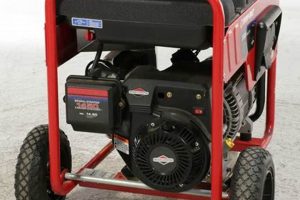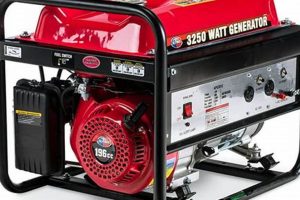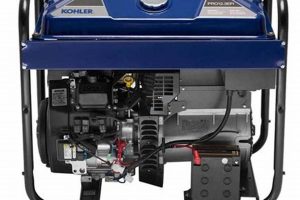Evaluating the acoustic output of various mobile power sources involves examining metrics like decibels produced at specific distances. For instance, one model might produce 60 decibels at 23 feet, while another generates 70 decibels at the same distance. Understanding these differences is essential for informed purchasing decisions.
Selecting a quieter generator can significantly impact the user experience and surrounding environment. Lower noise output minimizes disturbance to neighbors, supports conversation near the operating unit, and contributes to a more peaceful outdoor experience. Historically, generators were notoriously loud. However, advancements in engine design and noise-dampening technologies have led to quieter options, emphasizing the relevance of acoustic assessments.
This understanding empowers consumers to choose generators aligned with their noise tolerance and usage scenarios. Subsequent sections will explore specific decibel ratings of common models, factors influencing sound production, and strategies for mitigating generator noise.
Tips for Evaluating Generator Noise Levels
Careful consideration of noise output is crucial when selecting a generator. These tips offer guidance for effective evaluation and informed decision-making.
Tip 1: Focus on Decibel Ratings: Decibel (dB) levels provide a quantifiable measure of sound intensity. Lower dB values indicate quieter operation. Look for manufacturers’ specifications that detail dB levels at specific distances (e.g., 7 meters or 23 feet).
Tip 2: Consider Operating Environment: Anticipated usage scenarios influence acceptable noise levels. Generators intended for camping or residential use require lower noise output than those for construction sites or industrial applications.
Tip 3: Research Sound Profiles: Different generators exhibit varying sound characteristics. Some produce a low hum, while others emit a higher-pitched whine. Online reviews and videos can offer insights into real-world sound profiles.
Tip 4: Compare Models Side-by-Side: Whenever possible, compare dB ratings and sound characteristics across multiple models within the desired power range. This facilitates informed selection based on specific noise requirements.
Tip 5: Account for Load: Generator noise levels often fluctuate depending on the power load. Consider how noise levels might change during peak usage versus idling.
Tip 6: Explore Noise-Reduction Features: Some generators incorporate features designed to minimize noise, such as mufflers, sound-dampening enclosures, and advanced engine design. Consider these features when evaluating options.
By employing these tips, consumers can effectively evaluate generator noise levels and make informed purchases based on their specific needs and environmental considerations.
This careful evaluation process ensures optimal functionality while minimizing noise disturbance, ultimately leading to a more positive user experience.
1. Decibel (dB) Ratings
Decibel (dB) ratings serve as the cornerstone of portable generator noise level comparisons. Understanding these ratings is essential for evaluating the acoustic impact of different models and making informed purchasing decisions. dB ratings quantify sound intensity on a logarithmic scale, providing a standardized metric for comparing noise levels across various generators.
- Logarithmic Scale:
The logarithmic nature of the dB scale means that a seemingly small numerical difference represents a significant change in sound intensity. For example, a 10 dB increase represents a tenfold increase in perceived loudness. A 60 dB generator is perceived as twice as loud as a 50 dB generator, and four times as loud as a 40 dB generator. This understanding is crucial for interpreting dB ratings accurately when comparing generators.
- Distance from Source:
dB ratings are typically specified at a standardized distance from the generator, often 7 meters (23 feet). Sound intensity decreases with distance; therefore, understanding the specified measurement distance is crucial for meaningful comparisons. Comparing dB ratings measured at different distances can lead to inaccurate conclusions about relative noise levels.
- A-Weighted Decibels (dBA):
dBA ratings specifically measure sound frequencies within the range of human hearing, providing a more relevant metric for evaluating perceived loudness. Since human hearing is more sensitive to certain frequencies, dBA ratings offer a more accurate representation of how loud a generator will sound to the human ear compared to raw dB measurements.
- Contextual Examples:
Placing dB ratings in context helps consumers understand their practical implications. A 60 dB generator might be suitable for residential use, whereas an 80 dB generator is more appropriate for construction sites. Understanding the typical dB ranges associated with different environments allows consumers to choose a generator that meets their specific needs without causing undue noise disturbance.
By carefully considering dB ratings, distance from the source, and the use of A-weighted decibels, consumers can effectively utilize this information to conduct meaningful portable generator noise level comparisons. This ultimately empowers informed decisions, aligning generator selection with specific noise tolerance requirements and intended usage environments.
2. Tested Distance
Tested distance is a critical factor in accurate portable generator noise level comparisons. Sound intensity diminishes with distance from the source; therefore, standardized measurements ensure meaningful comparisons across different models. Understanding the specified tested distance allows consumers to interpret decibel (dB) ratings effectively and predict real-world noise levels at varying distances.
- Standard Distance:
Manufacturers typically specify noise levels at a standard distance, often 7 meters (23 feet). This standardized approach facilitates objective comparisons, ensuring that dB ratings reflect consistent measurement conditions. Without a standard, comparing noise levels from different manufacturers would be challenging and potentially misleading.
- Inverse Square Law:
The inverse square law governs sound propagation, stating that sound intensity decreases proportionally to the square of the distance from the source. For instance, doubling the distance reduces the sound intensity to one-quarter of its original value. This principle highlights the importance of considering the tested distance when evaluating generator noise levels for specific applications.
- Real-World Application:
Understanding the tested distance enables consumers to extrapolate noise levels to their specific usage scenarios. If a generator is rated at 60 dB at 7 meters, it will be significantly quieter at 14 meters, and considerably louder at 3.5 meters. This knowledge allows users to predict the noise impact on neighbors, conversations, and overall environmental tranquility.
- Comparison Accuracy:
Accurate comparisons require consistent tested distances. Comparing a generator rated at 60 dB at 7 meters with another rated at 65 dB at 4 meters provides limited insight. Only comparisons with consistent tested distances offer a meaningful assessment of relative noise levels. Inconsistent measurements can lead to erroneous conclusions and potentially unsuitable generator choices.
Tested distance, in conjunction with dB ratings, forms a cornerstone of portable generator noise level comparison. This understanding empowers informed decisions, aligning generator selection with specific noise tolerance requirements and anticipated operating conditions. By acknowledging the relationship between distance and sound intensity, consumers can effectively evaluate generator noise levels and choose models that minimize noise disturbance in their intended environments.
3. Operating Conditions
Operating conditions significantly influence portable generator noise levels. Factors such as load, fuel type, and ambient temperature affect engine operation and subsequent sound output. Analyzing these conditions provides crucial insights for comprehensive noise level comparisons. A generator operating under heavy load will typically produce more noise than one idling. Similarly, generators using different fuels may exhibit varying noise profiles. Ambient temperature can also impact engine performance and noise generation. Understanding these dependencies allows for more accurate comparisons and realistic expectations.
The relationship between load and noise output is particularly relevant. Increased power demand necessitates higher engine RPM and fuel consumption, directly correlating with increased noise levels. For instance, a generator powering a single lightbulb will operate much quieter than one powering multiple appliances simultaneously. Recognizing this cause-and-effect relationship allows consumers to predict noise levels based on anticipated power requirements. Fuel type also plays a role, with some fuels, like propane, generally producing quieter combustion than others. Ambient temperature further influences engine efficiency and noise levels, as extreme temperatures can strain engine components, resulting in increased noise. Practical application of this knowledge allows for informed generator selection based on anticipated operating conditions.
Therefore, effective portable generator noise level comparison requires careful consideration of operating conditions. Overlooking these variables can lead to inaccurate assessments and ultimately unsatisfactory performance. By analyzing the interplay between load, fuel type, ambient temperature, and resulting noise output, consumers gain a holistic understanding of generator performance, facilitating informed decisions aligned with specific usage scenarios and desired noise levels. This knowledge empowers users to select generators optimized for their particular needs, ensuring minimal noise disruption and optimal performance.
4. Sound Profile
Sound profile plays a crucial role in portable generator noise level comparison, moving beyond mere decibel levels to encompass the qualitative nature of the sound produced. While decibels quantify sound intensity, the sound profile describes the character of that sound, offering a more nuanced understanding of the noise experience. This qualitative assessment becomes particularly relevant when considering the impact of generator noise on surrounding environments and user comfort.
- Frequency:
Frequency, measured in Hertz (Hz), determines the pitch of the sound. Lower frequencies result in a deeper, rumbling sound, while higher frequencies produce a sharper, whining sound. A generator with a dominant low-frequency profile may be perceived as less intrusive than one with prominent high-frequency components, even at the same dB level. Considering the frequency composition is essential for evaluating the overall noise impact.
- Consistency:
Sound consistency refers to the steadiness of the noise output. Some generators produce a constant, even hum, while others exhibit fluctuating or pulsating sounds. Consistent noise is often easier to tolerate than erratic fluctuations, which can be more jarring and disruptive. Evaluating sound consistency aids in understanding the potential for noise annoyance.
- Harmonics:
Harmonics are multiples of the fundamental frequency produced by the engine. The presence and intensity of harmonics contribute to the overall sound quality. Generators with strong, unpleasant harmonics can be perceived as more irritating than those with a cleaner, more balanced harmonic profile. Analyzing harmonic content provides valuable insights into the perceived noise quality.
- Tonal Characteristics:
Tonal characteristics describe the overall perceived quality of the sound, such as whether it is rough, smooth, harsh, or mellow. This subjective evaluation complements the objective measurements of frequency and harmonics, providing a more complete picture of the noise experience. Understanding tonal characteristics helps predict the subjective perception of generator noise and its potential impact on the surrounding environment.
By analyzing the sound profilefrequency, consistency, harmonics, and tonal characteristicsalongside dB ratings, a more comprehensive understanding of generator noise emerges. This holistic approach facilitates more informed portable generator noise level comparisons, allowing users to select models that minimize not only sound intensity but also the subjective perception of noise pollution, leading to a more pleasant and less disruptive experience.
5. Noise-Reduction Technology
Noise-reduction technology plays a pivotal role in portable generator noise level comparison. Advancements in mitigating noise output significantly influence consumer choice, as quieter operation is highly desirable for various applications. Understanding the different noise-reduction technologies employed by manufacturers empowers informed comparisons based on both decibel levels and overall sound quality.
- Mufflers:
Mufflers are essential components designed to attenuate engine exhaust noise. Different muffler designs offer varying levels of noise reduction. Reactive mufflers utilize reflective chambers and baffles to cancel out sound waves, while absorptive mufflers use sound-absorbing materials to dissipate acoustic energy. Advanced mufflers often combine these approaches for enhanced noise suppression. Comparing muffler designs across different generator models provides valuable insights into their potential for noise reduction.
- Sound Enclosures:
Sound enclosures, also known as sound shields or canopies, provide an additional layer of noise reduction by physically encapsulating the generator. These enclosures typically utilize sound-dampening materials like foam or specialized composites to absorb and block sound waves. The effectiveness of a sound enclosure depends on its construction, material quality, and overall design. Evaluating the design and materials used in sound enclosures contributes to a more comprehensive understanding of their noise-reduction capabilities.
- Engine Design and Mounting:
Engine design and mounting significantly impact noise generation and transmission. Modern engines often incorporate features like low-vibration components and optimized combustion processes to minimize noise output at the source. Furthermore, specialized engine mounts isolate vibrations and prevent them from transferring to the generator’s frame, reducing overall noise levels. Analyzing engine design and mounting techniques provides valuable insights into a generator’s inherent noise characteristics.
- Cooling Systems:
Cooling systems contribute to generator noise levels. Traditional fan-based cooling systems can generate significant noise. Some modern generators utilize advanced cooling technologies, such as inverter technology or variable-speed fans, to minimize noise output. Evaluating the cooling system design aids in understanding its contribution to overall noise levels and allows for comparisons between models with different cooling approaches.
By considering these noise-reduction technologiesmufflers, sound enclosures, engine design, and cooling systemsconsumers gain a more comprehensive understanding of portable generator noise level comparisons. This knowledge empowers informed decision-making, allowing users to select generators that best suit their noise tolerance requirements and anticipated operating environments. Effective noise reduction contributes significantly to user comfort and minimizes environmental noise pollution.
Frequently Asked Questions
This section addresses common inquiries regarding portable generator noise levels, providing concise and informative responses to facilitate informed decision-making.
Question 1: How is generator noise measured?
Generator noise is typically measured in decibels (dB) using A-weighting (dBA), which accounts for the human ear’s sensitivity to different frequencies. Measurements are generally taken at a standardized distance, often 7 meters (23 feet).
Question 2: What is considered a quiet generator?
Generators producing less than 60 dBA at 7 meters are generally considered quiet. However, acceptable noise levels vary depending on the intended application and surrounding environment.
Question 3: Do inverter generators produce less noise than conventional generators?
Inverter generators generally operate quieter than conventional generators, particularly at lower loads, due to their variable engine speed and advanced electronic controls.
Question 4: How does load impact generator noise?
Increased load typically results in higher engine speed and greater noise output. Generators operating at full capacity will generally produce more noise than those under partial load.
Question 5: Can generator noise be reduced?
Several methods can reduce generator noise, including using sound-dampening enclosures, placing the generator on a vibration-absorbing surface, and maintaining adequate distance from noise-sensitive areas.
Question 6: What are the long-term effects of exposure to generator noise?
Prolonged exposure to high levels of generator noise can contribute to hearing loss and other health issues. Adhering to recommended safety guidelines and utilizing noise-reduction strategies minimizes potential risks.
Understanding these fundamental aspects of generator noise empowers informed selection and responsible operation. Careful consideration of noise levels ensures user comfort and minimizes environmental impact.
The subsequent section will delve deeper into specific generator models and their respective noise levels, providing practical examples for comparison.
Portable Generator Noise Level Comparison
Effective evaluation of portable generator noise levels requires a comprehensive understanding of various factors. Decibel ratings, tested distance, operating conditions, sound profile, and noise-reduction technologies all contribute to a complete assessment. Understanding the logarithmic nature of decibels, the inverse square law’s impact on distance, and the influence of load and fuel type on noise output empowers informed decision-making. Furthermore, considering the qualitative aspects of sound profile, including frequency, consistency, and tonal characteristics, allows for a nuanced evaluation beyond mere dB levels. Finally, recognizing the contributions of mufflers, sound enclosures, engine design, and cooling systems in noise reduction provides a holistic perspective on generator noise output.
Prioritizing informed portable generator noise level comparison ensures not only user comfort but also responsible environmental stewardship. Careful consideration of noise output contributes to harmonious coexistence within communities and minimizes disruption to natural soundscapes. As technology continues to advance, further refinement of noise-reduction strategies promises even quieter and more environmentally friendly power generation solutions. Selecting a generator based on thorough noise level comparison represents a commitment to both individual well-being and collective environmental responsibility.






